CHALLENGES AND HOPES
PEAT FIRE MANAGEMENT IN BORNEO ISLAND
BY DAYANG NUR SAKINAH MUSA AND XINYAN HUANG
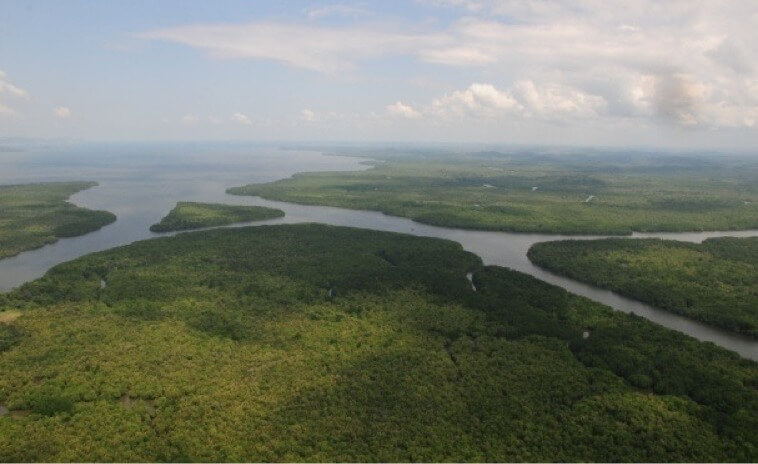
Borneo Island – the third largest island on the planet – is shared by Malaysia, Brunei, and Indonesia, and has one of the largest tropical peat swamp forests in Southeast Asia. This island serves as Earth’s lung, alongside the Amazon, circulating the majority of oxygen to our planet.
Despite covering three per cent of the global land surface, peatland on the island stores about one-third of global soil carbon. However, Borneo Island now frequently experiences long-lasting peat fires, creating haze over the region and releasing massive soil carbon. The peat becomes warmer and drier due to climate change, so fire is easier to ignite and become out of control.
PEAT FIRE PROBLEMS
Fire is not a natural process that frequently occurs on Borneo Island. With an intense tropical climate and precipitation all year, Borneo should not have fire-related issues.
“However, land clearance activities such as slash and burn that were practiced by the local community are the main contribution to peat fire spread to forest reserve,” said Musa Salleh, the head of Malaysia’s Sustainable Forest Management Division, Sabah Forestry Department, in an interview.
One piece of indirect evidence of human-caused fires in the peatlands is the fact that reported peat fires during the 2020-21 COVID-19 pandemic were the lowest in 30 years. Borneo’s lockdown policy forced people to stay home, and outdoor activity had been minimized since March 2020.
This change in human routines, and the seemingly related reduction in fires, is vital to help researchers understand the role of anthropogenic activities on reported peat fire cases. The peatland may not burn by itself, regardless of the dry season; human activity is a key reason for the ignition of these out-of-control wildfires.
With an understanding of the impact of pandemic restrictions on human movement, researchers and forest managers now can develop a better understanding of annual peatland wildfire activities in Southeast Asia.
Humans have pushed the Earth’s lungs to their limit over the past few decades. Looking back at the strong El-Nino season in 1997-98, the dense smoke from peat fires in the region caused an international haze and air pollution catastrophe. The Kalimantan province of Indonesia in the Borneo Island peatland was one of the fire epicenters.
Decreasing rainfall and increasing temperatures created by El-Nino affects the Malay Archipelago region every 10 to 15 years. In another strong El-Nino season in 2015-16, Kalimantan experienced extreme wildfire that affected critically endangered species such as the Orang Utan. Sabah, Malaysia, was also on fire from December 2015 through most of 2016. The recent Indonesian initiative to move its capital to Kalimantan will hopefully increase awareness of fire activities and reduce the number of peat fires on Borneo Island. To rehabilitate this area and prevent human-caused ignitions is a critical need, but it will take time and require global resources to have an effect. A rehabilitation approach such as a tree-planting program will help this area recover and be more resilient to peat fires. Preserving forest areas in protected spaces is also very important to reduce further damage of land clearing and wildfire.
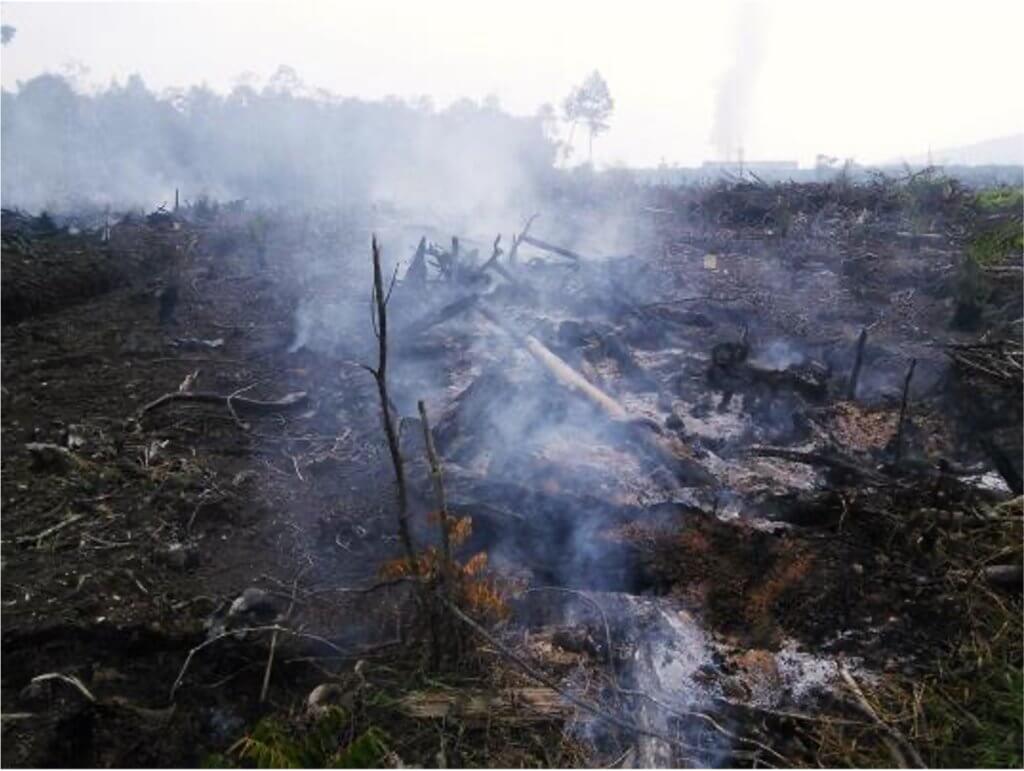
OIL PALM TREES
The growth of oil palm plantations on Borneo Island, especially in Central Kalimantan, Indonesia, has been well discussed. To facilitate palm oil production, deforestation has occurred, not only in peatland areas but other types of lowland forest.
The oil palm tree originated in Africa and was brought to Malaysia by the British, and to Indonesia by the Dutch in the mid-1800s as an ornament tree. Massive farming started in the early 1900s; Borneo’s tropical evergreen forest is perfect for oil palm growth.
Following the introduction of farming, slash-and-burn activities have continued for more than a century in Borneo and on Sumatra Island; the slash-and-burn processes constantly ignites the peat soil, causing never-ending underground fires, haze, and massive carbon emissions. Since the 2000s, more and more palm oil has been produced and imported to developed countries, particularly in the European Union, to meet their target of greenhouse gas reduction. Ironically, carbon emissions from the peat fires initiated by the slash-and-burn activities are at least 100 times more destructive to the environment than the savings of using palm oil.
Ecologically, palm oil trees cannot substitute the carbon storage or biodiversity of an evergreen forest, so sustainability cannot be achieved either. Now, both the international community and local government have developed an interest in growing palm oil more sustainably. Ceasing licensing of forest clearing for oil palm plantations in Central Kalimantan, however, is not an economically easy decision.
Sabah, Malaysia, is about to initiate a sustainable palm oil sector, as it has been the backbone of the local economy and improves the livlihood. The established oil palm plantation company was bound to a no-open-burning policy, thus is not a main factor for spreading the fire to the forest. With this revolutionary effort taking place, it is hoped that entire peat swamp forests can be protected by 2025.
Now, people in Sarawak, Malaysia, also believe that sustainable palm oil must be produced, and have implemented a sustainable palm oil policy. Introduction of the Malaysian Sustainable Palm Oil (MSPO) Certification Scheme is a vision to sustainably transform the Malaysia palm oil supply for the global market.
Malaysia and Indonesia pledge to halt deforestation by 2030; this is a hope to the conservationists, researchers, and forest manager for the forests on this island to recover. Eventually, this will reduce fire risk in peatland areas.
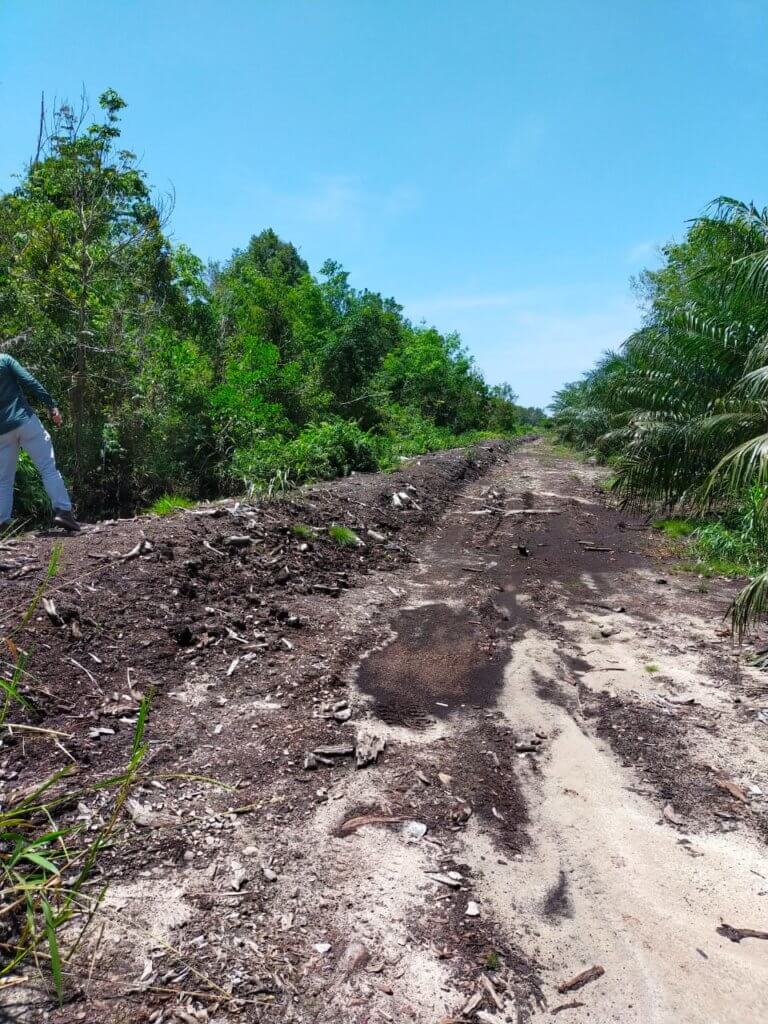
side in Sabah. When a fire spreads to the oil palm plantation, the forest
reserve will also be at risk. Photo by Dayang Nur Sakinah Musa
There is an initiative to protect this island that is recognized as the Heart of Borneo (HoB). This initiative was extended to Brunei Darussalam, Indonesia, and Malaysia. Many events related to the HoB conservation initiatives have been conducted in the past decade to protect the area. The initiative includes protecting the forest from wildfires. A high number of hotspots are often detected in Kalimantan, Sabah, and Sarawak, especially in the oil palm farm. After all, protecting this area from a forest fire is to protect the lungs of the planet.
PEAT FIRE MANAGEMENT
Given the hot climate of Malaysia, the risk of an accidental ignition in the peatland is always high. Along with human activities such as open burning and land clearing for agricultural purposes, the dry season usually worsens wildfires in the peatland. Thus, competent peat fire management is crucial.
“This fire can smolder for a week up to months,” said Datu Khirudin Drahman, director of the fire and rescue department of Sarawak.
Suddenly, it comes to our consciousness that in peat fire management, preventing the fire is the only way of managing this fire. This is not easy work, whether we try to prevent, control, or suppress it.
Monitoring the fire risk and a fast reaction to early-stage fire is often the first approach to control the situation. Monitoring can be done by using a drone and helicopter or observing from a watchtower, and the Fire Danger Rating System is used to monitor hotspots in high-risk areas. Patrolling the high fire risk areas by forest officers also helps. Early detection is crucial, and it is one of the best practices to control peat fire. There is an urgent research need for smart and reliable technologies for detecting and fighting these invisible fires.
Moreover, the local forestry department and fire rescue department has found that maintaining a high-water table is one of the most effective prevention measures that has been conducted to prevent the peat fire from smoldering below ground. The local fire service calls this strategy “total flooding.” Although the term is adopted from fighting building fires, it is more a fire-protection strategy for peatland. Sabah and Sarawak have installed more than 200 tube wells in the peatland to maintain the water table. These tube wells are the same as the water well placed in the peatland area where the fire frequency is high, to channel the water underground.
In the rainy season, the tube well will be ready to wet the land to prevent and combat peat fire. The tube well not only can moisten the peat layer but also supports the fire brigade to put out the peat fires. When the water table drops to a dangerous level that allows the upper layer of the peat to dry out, the local forest service will flood the area before observing any sign of fire, that is, identifying the most dangerous fire location and eliminating the fire risk, rather than suppressing the fire.
Other prevention measures are also crucial, such as establishing canal networks as fire breaks and regular training of the firefighters, villagers and workers of a company living surrounding peatland forests. The construction of a canal in the Klias Forest Reserve in Sabah is effective to prevent the fire spread to the forest, thus, the similar approach was implemented in the Binsuluk Forest Reserve.
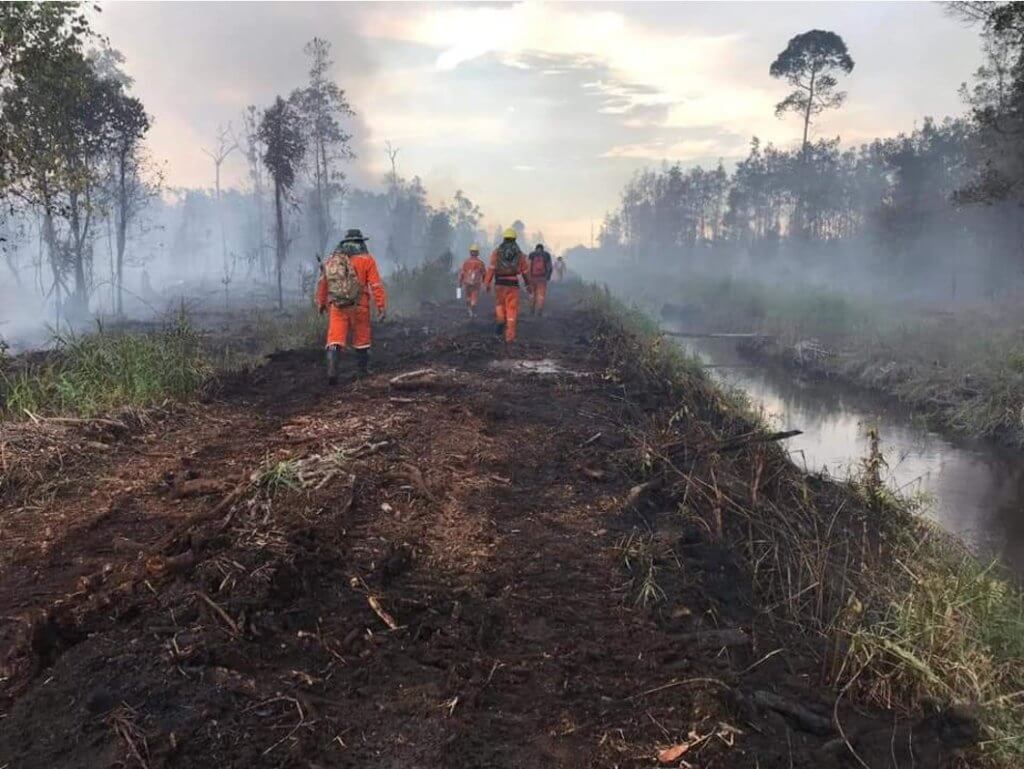
and right sides of the peatland. Photo courtesy of Sabah Forestry Department
FIGHTING PEAT FIRES
For the vast wildland in Borneo Island, no matter how many fire protection measures have been performed, peat fires still occur every year although the cases are minimal. Once a fire occurs, firefighters will adopt direct suppression methods such as total flooding and portable water pumps on the ground. Water-bombing by aircraft and helicopters are also used to support firefighters. The heat, flame, and toxic smoke pose great danger to the fire brigade.
It takes tremendous courage and determination to fully control a peat fire Afterwards, the fire brigade conducts mop-up operations to ensure the underground fire is fully extinguished. Firefighters often use a thermal image to continuously monitor the burnt area in case a “zombie” fire re-occurs. As the smoldering fire is invisible, more new technologies such as robotics and unmanned arial vehicles (UAVs) are needed to help fight and manage peat fires.
Sabah Forestry Department has established an initial attack crew of 80 members.
“This is our elite team, and everyone is well trained for peat fire suppression,” said Musa Salleh,
In case of fire, this crew will be at the front line.
“We ensure that the incident command system as a safety measure to be followed by the personnel, and our crew is in a good spirit during the suppression,” added Daim Balingi, deputy of Sustainable Forest Management Division, Sabah Forestry Department.
Most often, the fire brigade has to wait for rain to help control a peat fire. Water shortages regularly occur during the dry season, and there is a lack of water for fire suppression.
“If we have a water shortage, we have to wait for the rain to pour down to help ease the peat fire,” Salleh said.
Nevertheless, despite the extensive firefighting and monitoring efforts and the massive rainfall in the rain season, zombie fires will strike as some fires still smolder in the deep soil layer. These hidden fire spots cannot be accurately detected or fully extinguished unless the water table increases.
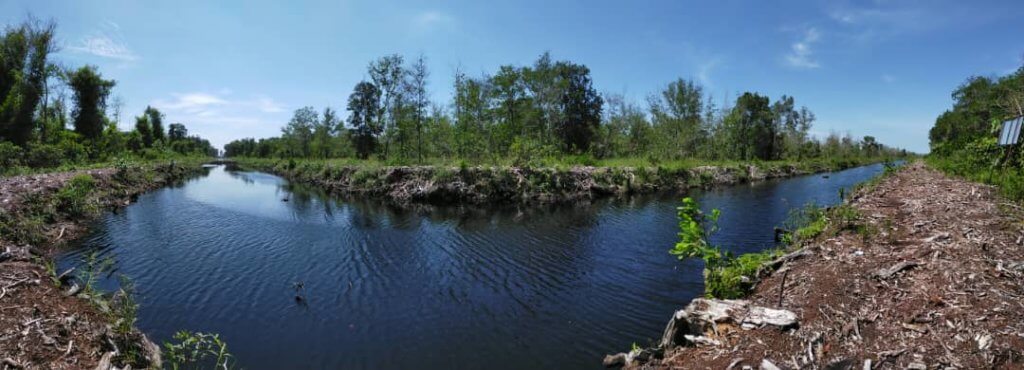
spreading to the forest reserve. Photo by Dayang Nur Sakinah Musa
Imagine the challenge when our forest fire managers and firefighters are combating these invisible fires inside the haze.
“Prevention is better than cure,” emphasized Datu Khirudin, the director of Fire & Rescue Department of Sarawak, Malaysia.
There is a hope that peat fires on Borneo Island can be controlled. The peat swamp forest is our great treasure. However, if we do not cherish it while spoiling the resource, peat fires will serve as a warning given by nature. Endless wildfire-fighting will be a zero-sum game unless we think about sustainability and learn how to live and prosper with nature.
Acknowledgement
The writers sincerely thank the interviewees from Malaysia, Musa Salleh and Daim Balingi from the Sabah Forestry Department, and Datu Khirudin Drahman from Fire & Rescue Department of Sarawak for providing valuable field experiences through interviews.
ABOUT THE AUTHORS
 Dayang Nur Sakinah Musa is a PhD student at Universiti Putra Malaysia and a visiting student at The Hong Kong Polytechnic University; she studies smoldering peat fire and suppression strategies in peat swamp forests. Dayang can be contacted at [email protected]
Dayang Nur Sakinah Musa is a PhD student at Universiti Putra Malaysia and a visiting student at The Hong Kong Polytechnic University; she studies smoldering peat fire and suppression strategies in peat swamp forests. Dayang can be contacted at [email protected]
Xinyan Huang is an assistant professor at The Hong Kong Polytechnic University; he is a combustion scientist and fire protection engineer. His research focuses on smoldering wildfires and the interaction between wildfire and climate. He is a board member of IAWF. Connect with Xinyan at [email protected]
